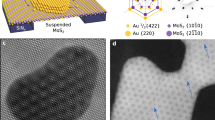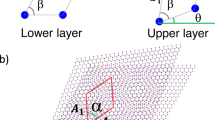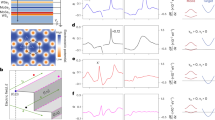Abstract
MOIRÉ patterns are interference fringes observed through two superposed, slightly misoriented diffraction gratings, or through two parallel gratings of slightly different spacing. When the misorientation between the gratings is very small the spacing of the moire fringes may be much greater than the grating spacing. Mitsuishi, Nagasaki and Uyeda1 observed that the lattice in thin sheets of crystal may act as gratings to produce moiré patterns in the electron microscope. More recently, Hashimoto and Uyeda2 have shown that dislocations in these crystals are revealed as dislocations in the moiré patterns, and Pashley, Menter and Bassett3 have recorded moiré patterns in specimens consisting of one metal epitaxially evaporated on to a single crystal film of another metal.
This is a preview of subscription content, access via your institution
Access options
Subscribe to this journal
Receive 51 print issues and online access
$199.00 per year
only $3.90 per issue
Buy this article
- Purchase on SpringerLink
- Instant access to full article PDF
Prices may be subject to local taxes which are calculated during checkout
Similar content being viewed by others
References
Mitsuishi, T., Nagasaki, H., and Uyeda, R., Proc. Jap. Acad., 27, 86 (1951).
Hashimoto, H., and Uyeda, R., Acta Cryst., 10, 143 (1957).
Pashley, D. W., Menter, J. W., and Bassett, G. A., Nature, 179, 752 (1957).
Hirsch, P. B., Horne, R. W., and Whelan, M. J., Phil. Mag., 1, 677 (1956).
Bradley, D. E., and Phillips, R., Proc. Phys. Soc., B, 70, 533 (1957).
Author information
Authors and Affiliations
Rights and permissions
About this article
Cite this article
GEACH, G., PHILLIPS, R. Moiré Patterns in Transmission Electron Micrographs of Sub-Boundaries of Aluminium. Nature 179, 1293 (1957). https://doi.org/10.1038/1791293a0
Issue date:
DOI: https://doi.org/10.1038/1791293a0



